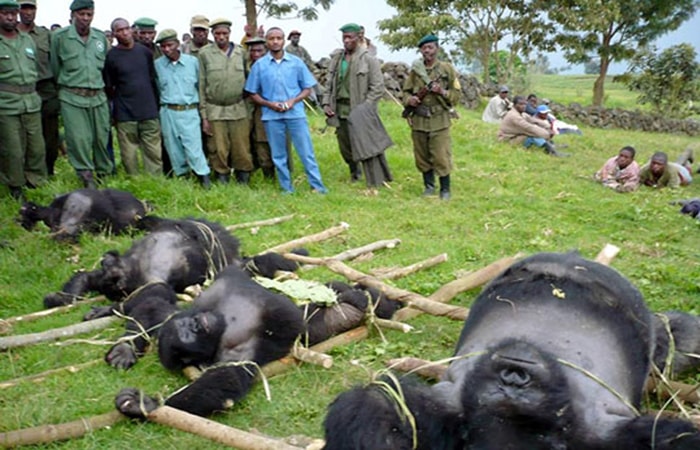Threats to the Survival of Mountain Gorillas in the Wild
The threats to the survival of mountain gorillas are both man-made and natural. The threats include diseases, habitat degradation or loss due to mining, poaching, wars or political conflicts, logging and agriculture, diseases, most notably Ebola and many more. Mountain gorillas live in the thick tropical forests in East and Central African countries. In Uganda, these gorilla inhabit Bwindi Impenetrable National Park and Mgahinga Gorilla National Park. These are the only two gorilla habitats in Uganda. While in Rwanda, mountain gorillas are found in the Volcanoes National Park (Parc Nationale Des Volcans) in the areas of Ruhengeri. Virunga National Park is the home to Mountain gorillas in the Democratic Republic of Congo. Below are the major threats to mountain gorillas in Uganda, Rwanda and Congo:-
Poaching and Hunting
Poaching is the illegal hunting or capturing of wild animals for meet, trade or pave space for land use. Poaching has been a threat to the gorillas for a long time until recently when government and international bodies came to the plight of the gorillas. In 1985, Dian Fossey, a renowned primatologists was allegedly killed by poachers around the Volcanoes National Park in Rwanda. Her death is attributed to mountain gorilla poachers whom she was fighting. This is how bad and terrible poaching can.
 It is assumed that in the first 20 years after the discovery of gorillas, Europeans and American Researchers and trophy hunters exterminated over 50 mountain gorillas. To date, the poaching habit still antagonize the existence of mountain gorillas. Poaching gorillas for meat consumption is uncommon today. Some gorillas have been victims of indiscriminate hunting with traps and snares set for catching other animals like antelopes, bush pigs, kobs and many more. Coincidentally, gorilla fall into such snares and get killed.
It is assumed that in the first 20 years after the discovery of gorillas, Europeans and American Researchers and trophy hunters exterminated over 50 mountain gorillas. To date, the poaching habit still antagonize the existence of mountain gorillas. Poaching gorillas for meat consumption is uncommon today. Some gorillas have been victims of indiscriminate hunting with traps and snares set for catching other animals like antelopes, bush pigs, kobs and many more. Coincidentally, gorilla fall into such snares and get killed.
Habitat Loss
The main threat to the survival of mountain gorillas is deforestation by human beings in a bid to secure space for agriculture and shelter. Conversion of land for farming and competition for inadequate natural resources like firewood and timber result into worrying degrees of forest destruction. There is a need to develop alternative economic activities that enable people address their economic needs rather than relying on forests for survival. This way, the endangered maintain gorilla habitat will be preserved and no one will look at the gorillas as competitors in the struggle for existence.
Diseases
Since gorillas are nearly similar to human beings in terms of bodily and biological features, it makes them vulnerable to many of the same human diseases. Gorillas have not attained the essential protections. Most of the diseases that affect humans can easily affect the gorillas in their habitats. That is why, gorilla parks have a list of set gorilla trekking rules and regulations aimed at protecting the primates and the humans that visit them. Any sick human contact to gorillas is possibly detrimental to the lives of the endangered primates.
For instance Gorilla visitors are tutored to keep 7 meters away from them, a thing is a health initiative to protect the lives of the visitors and the visited. To the gorillas, people of all categories like conservationists, rangers, scientists, researchers, poachers, militia groups as well as local communities can potentially threaten their lives. Gorillas can potentially succumb to known skin diseases such as scabies or respiratory diseases that may be passed onto other members of a given gorilla family.
Political Conflicts
The existence of political conflicts especially Eastern Democratic Republic of Congo has to some extent affected the lives of Mountain gorillas in the Virunga National Park. During unrest, no attention is paid to the gorillas. Also lawlessness in the midst of conflict aggravates other life-threatening causes like disease, poaching and habitat loss since there would be authorities to do enforcement. For instance during conflicts, forests are cut for timber, poaching for meat is also done for survival as well as disease increase since there is no care as conservationists run to their own safety.
